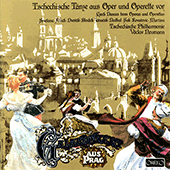
Oskar Nedbal (1874 - 1930)
Rejected initially as a violin student (although he had learnt as a child), Oskar Nedbal took lessons on the trumpet and then percussion when he began at the Prague Conservatory aged ten or eleven. He eventually got into Antonín Bennewitz’s violin class but was steered towards the viola because of his powerful physique. Bennewitz, who also taught Josef Suk I and Ševčík, and whose musical lineage goes back to Viotti, was a major figure in the Czech musical tradition. The Chamber Music Association which he cofounded encouraged and inspired a readily discernible national style amongst Czech performers and composers. Nedbal also benefitted from composition classes with Dvořák. He and Suk were star pupils at the time and remained close to Dvořák after graduating from the Conservatory, Dvořák considering Nedbal the finest interpreter of his music (including as a conductor).
As violist of the immensely successful Bohemian Quartet (in which Suk also played second violin), Nedbal made a great impression on Carl Flesch, who heard the ensemble’s first performance in 1892 and commented: ‘One was hearing real viola playing for the first time.’ In this early part of Nedbal’s career he also began to make his way as a conductor and composer—his first tour outside Austria-Hungary was to conduct the Czech Philharmonic in England in 1902. His compositions are wide-ranging, from classically-themed solo and chamber works (many of which reflect his deep respect for Dvořák) to light opera. He began writing in the latter genre after suddenly departing from the Bohemian Quartet (taking with him the leader’s wife) in 1906; his operetta style was an innovative fusion of Viennese and Germanic preconceptions with the more surprising East-European folk rhythms of his heritage. His life came to a tragic end when, apparently deeply in debt, he committed suicide by jumping from an upper storey of the Zagreb Opera House.
In the early 1890s Nedbal was doing well as a viola soloist, his repertoire including Mozart’s Sinfonia concertante, which he performed with both Kubelík and Huberman, and Rubinstein’s less well-known Viola Sonata. Although his solo recordings are few in number, their historical significance is paramount; listening to the two items selected here, recorded in 1910 and 1911 respectively, one hears at once what is possibly the most stylistically conservative viola playing on record, directly comparable (in spite of the fact that Nedbal was born more than forty years later) with the sound world of Joseph Joachim. Nedbal’s Romantický Kus is thus delivered with a very pure tone, with the merest hint of vibrato and some long, languid portamenti suggestive (partly owing to the instrument’s timbre) of early recordings of cellists. It is interesting to note his unabashed use of open strings and harmonics in both of these items, which testifies to a tonal aesthetic that did not consider the vibrato to be central to expressive tone—clear evidence of the survival of pre-twentieth-century performing style. Nedbal’s composition is charming and a further example of the kind of short salon pieces often written by performers of this period. His own arrangement of Schubert’s song Du bist die Ruh is of immediate interest in a wider sense, the unnamed pianist using a form of tempo dislocation (usually, allowing freedom of rhythm and tempo in the melodic line over a steadier accompaniment) and chordal arpeggiation that are commonly heard on early sound recordings and piano rolls. The viola playing is noble and delicate: a very slight vibrato at the start and in the lower reaches of the instrument results in a most refined and resonant tone, despite the technical limitations of this very early recording. Although these two performances are short and not of heavyweight repertoire, their historical importance as some of the earliest solo viola recordings, demonstrating certain nineteenth-century performing practices, cannot be underestimated.
© Naxos Rights International Ltd. — David Milsom (A–Z of String Players, Naxos 8.558081-84)

















